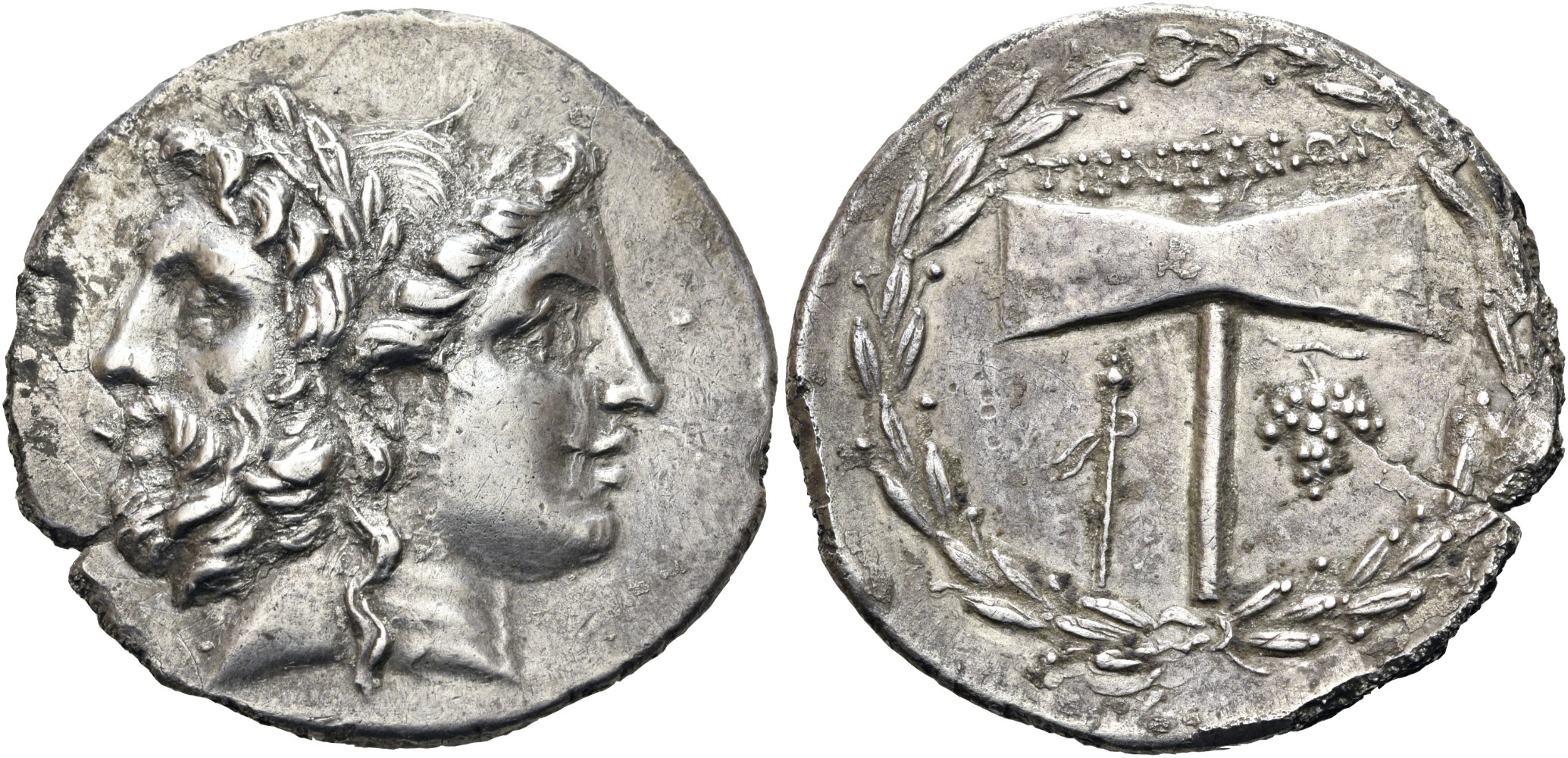Tenedos, silver, tetradrachms (100-70 BCE)
From SILVER
(Redirected from S 322 - Tenedos, silver, tetradrachms (90-70 BCE))
100 BCE - 70 BCE Silver 7,956 kg
Description
| ObverseInscription or printing placed on the obverse.: | Janiform head, male and bearded left, female and wearing a crown right. |
| ReverseInscription or printing placed on the reverse.: | TENEΔIΩN (Greek).Double axe. In the left field, bunch of grapes and monogram. In the right field, symbol (bunch of grapes, Dionysos, Artemis, palm, lyra, eagle, Athena, etc). All within a wreath. |
Mint and issuing power
| MintIdentifies the place of manufacture or issue of a numismatic object.: | Tenedos | Ancient regionAncient region.: | Troas | Modern countryModern country: Turkey | AuthorityIdentifies the issuing power. The authority can be "pretended" when the name or the portrait of X is on the coin but he/she was not the issuing power. It can also be "uncertain" when there is no mention of X on the coin but he/she was the issuing power according to the historical sources: |
Chronology
| FromIdentifies the initial date in a range assigned in a numismatic context. | 100 BCE | toIdentifies the final date in a range assigned in a numismatic context.. | 70 BCE | PeriodTime period of the numismatic object.: Hellenistic 323-30 BC |
Physical description
| MetalThe physical material (usually metal) from which an object is made.: | Silver |
Median weightMedian of the weights of numismatic objects (in grams). in grams | 16.35 | DenominationTerm indicating the value of a numismatic object. Examples: tetradrachm, chalkous, denarius.: | tetradrachm |
StandardStandard.: | Attic |
Image

RQEM ad. 322 - Tenedos, silver, tetradrachm, 90-70 BC.jpg [1]
References
| Die study referencePublication of the study: | Callataÿ 19981Callataÿ 1998 | ||
| Coin series referenceReference to coin series study: | Sear II2Sear II, n° 4157, HGC 63HGC 6, n° 390 | ||
Obverse dies distribution
| FrequencyFrequency of specimen in distribution. ᵖ | Number of obversesNumber of obverse dies. ᵖ (o) | % (o) | Number of coinsNumber of coins. (n) | % (n) | Die nameName(s) of the die(s). |
| 1 | 8 | 38.1 | 8 | 9.3 | 1, 2, 4, 5, 10, 12, 15, 16 |
| 2 | 2 | 9.52 | 4 | 4.65 | 6, 8 |
| 3 | 2 | 9.52 | 6 | 6.98 | 7, 17 |
| 4 | 3 | 14.29 | 12 | 13.95 | 3, 14, 19 |
| 6 | 1 | 4.76 | 6 | 6.98 | 21 |
| 7 | 1 | 4.76 | 7 | 8.14 | 18 |
| 8 | 2 | 9.52 | 16 | 18.6 | 9, 11 |
| 11 | 1 | 4.76 | 11 | 12.79 | 20 |
| 16 | 1 | 4.76 | 16 | 18.6 | 13 |
| Total | 21 of 21 | 99.99 | 86 of 86 | 99.99 |
Reverse dies distribution
no distribution is available
Quantification
| Number of obversesNumber of obverse dies. ᵖ (o) | 21 | Number of singletons (o1)The number of singleton coins. ᵖ | 8 |
| Number of reverse diesNumber of reverse dies. (r) | 75 | Number of coinsNumber of coins. (n) | 86 |
| Coins per obverse dieNumber of coins per obverse die. (n/o) | 4.1 | Coins per reverse dieNumber of coins per reverse die. (n/r) | 1.15 |
| Reverse per obverse ratioRatio of obverse dies divided by reverse dies. (r/o) | 3.57 | Percentage of singletons (o1)number of coins (n) divided by the number of singletons (o1) ᵖ | 38.1 % |
| Original number of dies (O) (Carter 1983 formula)The estimation of the number of coins according to Carter 1983 ᵖ | 24.33 | Coins struck if 20,000 as average productivity per dieCoins made if the average productivity for obverses (according to Carter) is 20,000. ᵖ | 486,600 |
| Original number of dies (O) (Esty 2011 formula)The estimation of the number of coins according to the singleton formula in Esty 2011 ᵖ (O) | 27.78 | Survival rate if 20,000 as average productivity per dieSurvival rate if average productivity is 20,000. ᵖ | 0.00018 |
| Coverage (o = % of O) (Esty 1984 formula)Esty 1984 - coverage (% of O) ᵖ (o = % of O) | 90.7% | Die productivity if survival rate 1/2,000Average productivity if survival rate is 1/2,000. ᵖ | 7,069.46 |
| Weight of silver (in kg) if 20,000 coins per die (O = Carter formula)Carter 1983 * Median weight * 20000 (*10 if gold or electrum) ᵖ | 7,956 kg <br /> 7,956 kg | Die productivity if survival rate 1/5,000Average productivity if survival rate is 1/5,000. ᵖ | 17,673.65 |
Remarks
Most likely one single workstation Likely military